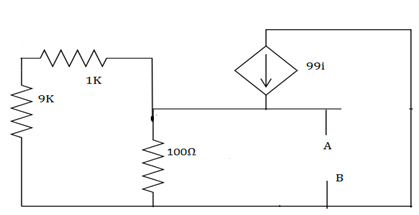This set of Electronic Devices and Circuits Mcqs focuses on “The AC Analysis of a Small-Signal Low-Frequency Common Emitter Transistor”.
1. The feature of an approximate model of a transistor is
a) it helps in quicker analysis
b) it provides individual analysis for different configurations
c) it helps in dc analysis
d) ac analysis is not possible
View Answer
Explanation: The small signal model helps in quicker ac analysis of a transistor. The approximate model is applicable for all the configurations. The dc analysis is not obtained by using a small signal model of transistor.
2. A transistor has hfe=100, hie=2kΩ, hoe=0.005mmhos, hre=0. Find the output impedance if the lad resistance is 5kΩ.
a) 5kΩ
b) 4kΩ
c) 20kΩ
d) 15kΩ
View Answer
Explanation: RO=I/hoe=1/0.005m
=20kΩ.ROI= RO || RLI=20||5
=4kΩ.
3. A CE amplifier when bypassed with a capacitor at the emitter resistance has
a) increased input resistance and increased voltage gain
b) increased input resistance and decreased voltage gain
c) decreased input resistance and increased voltage gain
d) decreased input resistance and decreased voltage gain
View Answer
Explanation: When a transistor is bypassed with a capacitor, it short circuits in the small signal analysis of transistor and the resistor too shorts. The input resistance becomes RI=hie. The value of the input resistance is decreased and the gain now will be increasing.
4. A transistor has hie =2kΩ, hoe=25µmhos and hfe=60 with an unbypassed emitter resistor Re=1kΩ. What will be the input resistance and output resistance?
a) 90kΩ and 50kΩ respectively
b) 33kΩ and 45kΩ respectively
c) 6kΩ and 40kΩ respectively
d) 63kΩ and 40kΩ respectively
View Answer
Explanation: As the emitter is unbypassed, the input resistance Ri=hie+(1+hfe)Re
=2+61=63kΩ. The output resistance RO=1/hoe=1/25MΩ=40kΩ.
5. A transistor has hie =1KΩ and hfe=60 with an bypassed emitter resistor Re=1kΩ. What will be the input resistance and output resistance?
a) 90kΩ and 50kΩ respectively
b) 33kΩ and 45kΩ respectively
c) 6kΩ and 40kΩ respectively
d) 63kΩ and 40kΩ respectively
View Answer
Explanation: As the emitter is bypassed, the input resistance Ri=hie
=1kΩ. The output resistance RO=1/hoe but the value is not given.
So, hoe=0 and RO=1/0=∞.
6. In the given circuit, find the equivalent resistance between A and B nodes.

a) 100kΩ
b) 50kΩ
c) 40kΩ
d) 60kΩ
View Answer
Explanation: RAB=RO||100Ω
= (RSI+hie/1+hfe)||100
=9+1/100||100=100||100=50Ω.
7. Which of the following acts as a buffer?
a) CC amplifier
b) CE amplifier
c) CB amplifier
d) cascaded amplifier
View Answer
Explanation: The voltage gain of a common collector amplifier is unity. It is then used as a buffer. The CC amplifier is also called as an emitter follower. Though there is no amplification done, the output will be stabilised.
8. Which of the following is true?
a) CC amplifier has a large current gain
b) CE amplifier has a large current gain
c) CB amplifier has low voltage gain
d) CC amplifier has low current gain
View Answer
Explanation: The CE amplifier has high current and voltage gains. The CC amplifier has unity voltage gain which cannot be regarded as high. The common base amplifier has a unity current gain and high voltage gain.
9. In an NPN silicon transistor, α=0.995, IE=10mA and leakage current ICBO=0.5µA. Determine ICEO.
a) 10µA
b) 100µA
c) 90µA
d) 500µA
View Answer
Explanation: IC=α IE +ICBO =0.995*10mA+0.5µA=9.9505mA.
IB=IE-IC=10-9.9505=0.0495mA. β=α/(1-α)=0.995/(1-0.995)=199
ICEO=9.9505-199*0.0495=0.1mA==100µA.
10. In CB configuration, the value of α=0.98A. A voltage drop of 4.9V is obtained across the resistor of 5KΩ when connected in collector circuit. Find the base current.
a) 0.01mA
b) 0.07mA
c) 0.02mA
d) 0.05mA
View Answer
Explanation: Here, IC=4.9/5K=0.98mA
α = IC/IE .So,
IE=IC/α=0.98/0.98=1mA.
IB=IE-IC=1-0.98=0.02mA.
Sanfoundry Global Education & Learning Series – Electronic Devices and Circuits.
To practice MCQs on all areas of Electronic Devices and Circuits, here is complete set of 1000+ Multiple Choice Questions and Answers.
If you find a mistake in question / option / answer, kindly take a screenshot and email to [email protected]
